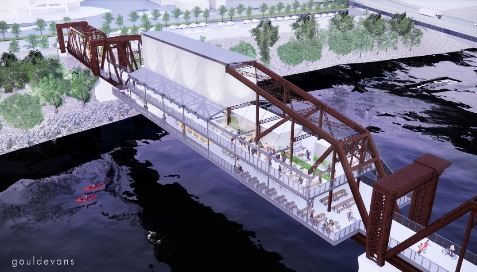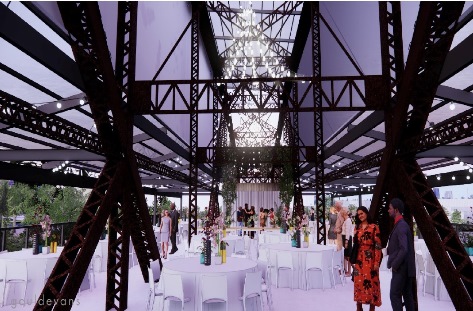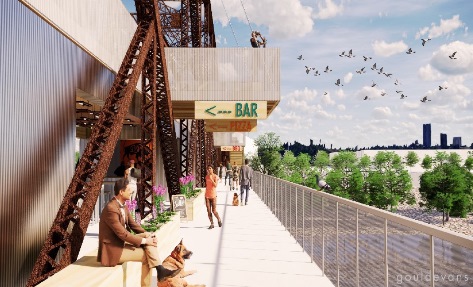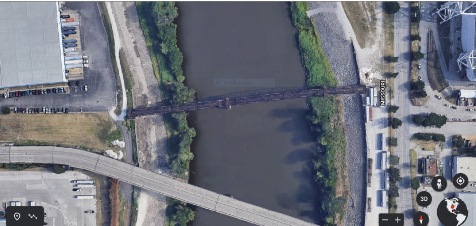



An agreement for the redevelopment of the Rock Island Railroad Bridge over the Kaw River received preliminary approval on Monday night at a Unified Government committee meeting.
The Economic Development and Finance Committee voted unanimously in favor of the project.
The bridge will be renovated into an event space with restaurants, and it also will be a walking and biking trail connecting Kansas City, Kansas, to Kansas City, Missouri, according to UG officials.
The project has been discussed for a few years, with some changes made to the original proposal.
Katherine Carttar, UG economic development director, said the redevelopment of the bridge is part of a larger plan to reinvent the riverfront and provide access to the river.
She said other cities that have invested in riverfront projects have seen a lot of return on their investment.
“We have a beautiful river and are unable to access it at this time,” she said.
There is currently a multifamily housing project nearby, on the Kansas side, as well as the $500 million levee improvement project, she said. With the levee improvements, there will be 20 miles of levee trail available to hikers and bikers. The bridge will connect Kansas trails with Missouri trails.
The bridge in question was built in 1905 and hasn’t been used since the 1970s, Carttar said. She credited Michael Zeller and his Flying Truss team for thinking outside the box and coming up with a plan to use the bridge in a creative reclamation, getting rid of blight in a creative way.
Zeller said at the meeting originally he thought the railroad bridge was a good place to put an event space. Later, after talking with UG officials, he made changes in the plans to include a hiking trail and bike trail on the bridge. Now the bridge will be both a trail and a destination, according to Zeller.
Zeller said heavy steel cantilevers will be added to both sides of the bridge.
On the south side will be an entertainment district. The lower level of the bridge will include a trailhead with restrooms, fountains, bike racks, seating, and an open public space where people may wander in and out, get lunch or coffee, he said. Currently, they are looking at a food hall concept with different types of food available.
The top deck will have an event space available for rental, restrooms, a coffee shop and bar, he said.
There are plans for a community kitchen, and he has been talking to some independent restaurant operators in Kansas City, Kansas, about providing the food, he said.
They also are working with groups that would teach children how to canoe on the river, he said. They’re also discussing a staircase to the waterfront, and there would be a kiosk that would rent small craft.
There will be a community zone at the western entrance, with a kitchen, and space for organizations that serve youth, he said. That side would be where people could go hiking, boating and camping, according to Zeller.
“Bridgette Jobe (Kansas director of tourism) has been calling this bridge the front door to Kansas,” Zeller said. The bridge is 100 feet from the state line, about a minute’s walk from the HyVee Arena in Kansas City, Missouri, he said.
Zeller said there are future phases planned for the project, such as a zip line across the state line and river. The seventh to eighth year, they’re planning a sit-down restaurant on top of a heavy-duty lift gate. More gardens, arts and activities will be included in the future, he said.
He said an analysis was done by an independent firm that concluded this project could achieve its goal of serving as a keystone for trails on both sides of the state line. The project should create 65 jobs and draw 360,000 visitors.
More than that, it is expected to be a catalyst for the riverfront area, he said. Zeller said it could become America’s first landmark destination bridge. As an attraction, the bridge could become one of the things that people will think of when they say “Kansas City,” Zeller said the analyst stated.
Carttar said they see this project as a catalyst to encourage future development on both sides of the river. Also, this provides a way for local residents to get outdoors, be active and improve their quality of life and their health by going on a trail, renting a canoe or kayak, according to Carttar.
Carttar said the study done a few months ago conservatively estimated about 250,000 annual visitors to the bridge.
The project would cost a total of $4.975 million, with $2 million of it from the UG, Carttar said. She said it would really be an investment in the UG’s riverfront development. The UG’s $2 million would come from tourism funds from the tax on hotel rooms in the county.
She said the consultant estimated that if the UG put a TIF district in place, with incremental property and sales tax, with a 2 percent community improvement district, it would raise sufficient money for the project. They anticipated it would be about 12 to 13 years when it would be fully repaid, she said.
According to the development agreement, up to $75,000 of the $2 million would be available to the developer early in the project for engineering and the site plan. The rest of the $2 million would be the last of the funds to be given to the developer, and the developer would have to meet conditions in order to receive the funds, according to Carttar.
Carttar said the UG would get its investment back, over the years, through revenues, rent and taxes.
Kansas City, Missouri, currently owns the railroad bridge, and the UG has an agreement with them to transfer the bridge to the UG for $1, according to Carttar. She said the UG wanted to own the bridge and to have control of the bridge in case anything were to happen in the future.
The UG would rent the bridge to Flying Truss for 33 years, with a 33-year option to renew, she said. The rent would start at under $10,000 a year and increase over time, she said. Flying Truss would operate the bridge and sublease to restaurants, according to Cartttar. The agreement calls for Flying Truss to be responsible for maintenance, with the contractor taking maintenance responsibility for the public trail and trailhead on the bridge, she said.
Under the agreement, the UG would be able to use the bridge for programs throughout the year.
According to Todd LaSala, an outside attorney for the UG, the development agreement says if there are shortfalls, the developers will write the UG a check. The UG expects to get about $10,000 a month from revenues, he said. Also, the developer will maintain the bridge, pay taxes on it, and insure it, he said.
Commissioner Jim Walters asked about a clause in the agreement that says the UG is responsible for some improvements, including the design and construction of parking improvements on the west side, trail connections to the bridge and ADA-accessible ramps on both sides of the bridge. According to Carttar, the UG would pay for these improvements, and at this time, there was no estimate given of their exact cost, although Carttar said it would be less tha a million dollars. The costs are in addition to the UG’s $2 million, according to Carttar.
Commissioner Gayle Townsend requested that the project have minority and women-owned local businesses involved.
While there is a clause in the agreement for construction firms to have minority and women-owned businesses, there isn’t a clause requiring it for any vendors that may be there.
Commissioner Townsend said she would like to see local restaurants such as Wilson’s Pizza, from the northeast area be vendors there. She said she would like to see more teeth in the agreement to make sure there are minority and women-owned businesses.
The minority and women-owned business clause is not in the agreement, and LaSala said it could be difficult as the restaurants will sublease from the developer. The UG is a step removed from it, he said. Zeller said he had held preliminary meetings with some business owners in these groups.
Commissioner Harold Johnson agreed that it is important to him, also, that there be minority and women-owned local business vendors there.
Commissioner Townsend said it’s important to her to have minority and women-owned vendors as lessees on the bridge because she thinks the bridge project is really going somewhere, and it’s important to have Wyandotte County vendors on that bridge. She said some teeth is needed in the agreement.
Commissioner Tom Burroughs said he has invited Lt. Gov. and Commerce Secretary David Toland to look at the bridge project in April. Burroughs said he would like to find additional investment partners so they can expand the project for the future phases.
Several residents expressed support for the bridge project, including Edgar Galicia, executive director of CABA.
“This is a destination site but it’s just the beginning,” Galicia said.
The Central Avenue area is near the project and he said he would like to see growth from this project connect to the Central area.
Mike Pearce of Slap’s BBQ, 553 Central, told the committee that he hoped this project could pull people across the river who would patronize local businesses.
Benjamin Walker, a Realtor and Armourdale resident, said the bridge would be a catalyst. Also the project would help preserve nature and history, while also giving youth in the community a place to go.
Daniel Serda said the bridge project should reinforce to everyone how integral the stockyards were to the growth of the region. Without them, they wouldn’t have the major city there is today, he said. Without industries in Armourdale, there wouldn’t have been a major city.
Serda said projects like this in other cities have generated from six to 40 times the local government investment. Investments like this dramatically increase the value of surrounding real estate, he said. He also said the project, with its trails and canoes, would be beneficial for kids.
The project also received support from Armourdale Renewal Association officers and Armourdale residents.
Bridgette Jobe, Kansas director of tourism, sent a letter of support, saying she envisioned the project as “the vibrant front door to KCK.” She said it was likely that during every NASCAR race at the Kansas Speedway, pictures of it would be broadcast. Also, the division of tourism is supporting it with a grant to assist in development.
Commissioner Burroughs said he received communications from the Wyandotte County Economic Development Council in support of the project.
Phil Donnellan, with the Kansas City Rowing Club, supported the project and said he thinks the project would be a catalyst to bring people to the river as a destination and part of the trail. One day, he said, they would like to build a boathouse on the river. The club holds annual races but he said they may be able to hold more competitions with the food available on the bridge.
The issue is scheduled to be heard again at the full UG Commission meeting May 13.
Agreement details are included in the detailed UG agenda for the March 29 EDF meeting, at https://www.wycokck.org/Clerk/Agendas.aspx.
The meeting can be viewed on YouTube at https://www.youtube.com/watch?v=BoPiSH_nA5A
.

Its way past time, but need to do this out here between Johnson County and Edwardsville/Bonner area where you more than likely have more hikers and bikers. The UG already put up signs several years back on Woodend so no one can park on the side of the road just to keep people from getting to the river.
There are a lot of people that like to access the river on the east side of 435 at Woodend, and UG should spend about 100 dollars taking down those no parking signs so we can. It’s ridiculous, have a river and no way to get to it, useless and short sighted, no vision mayors and council people here for decades.
I guess when you’re in politics there’s just no time for fishing/exploring. My best day there long ago was when i landed two hybrids right at 30″ apiece on 6# test – very difficult.